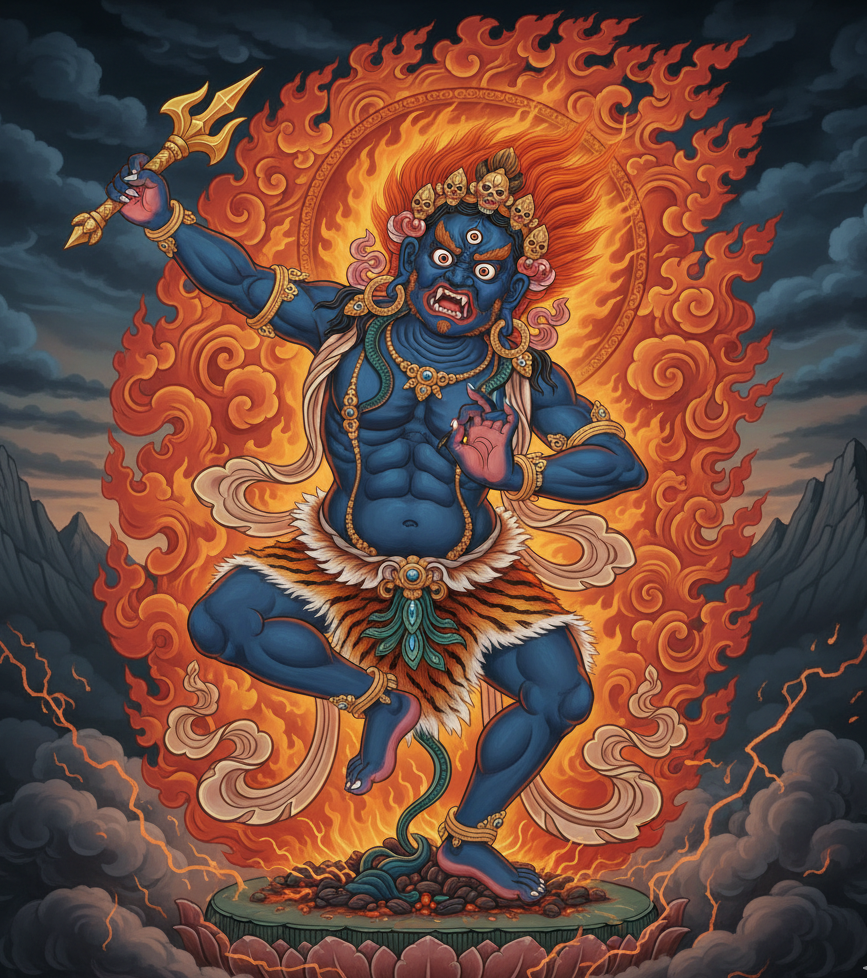Holder of the Thunderbolt: Vajrapāṇi
Vajrapāṇi is a bodhisattva in Mahāyāna Buddhism, known as the "Thunderbolt-Bearer" and symbolizing the power of all buddhas. He is one of the earliest protectors of the Buddha and is often depicted as a wrathful, blue-skinned figure holding a vajra (thunderbolt).
10/12/20252 min read


Vajrapāṇi, a central figure in Mahāyāna Buddhism, is revered as one of the earliest Bodhisattvas, embodying the formidable enlightened power and boundless energy of all Buddhas. His name, translating to "Holder of the Thunderbolt," encapsulates his essence as a wielder of the vajra, a powerful symbol representing both a diamond's indestructible nature and a thunderbolt's irresistible force. This vajra signifies the unyielding wisdom that shatters the illusions of ignorance and delusion, paving the way for spiritual awakening.
Often depicted in a wrathful yet compassionate form, Vajrapāṇi's fierce appearance serves not as a symbol of aggression, but as an expression of his unwavering resolve to protect the Dharma and its practitioners from all obstacles, both internal and external. He is a formidable Dharmapāla, or Dharma Protector, tirelessly guarding the Buddhist teachings and empowering practitioners with the courage and strength needed to navigate the challenges of the spiritual path. His iconography, rich with symbolism, typically portrays him with a muscular, blue-skinned physique, a tiger-skin loincloth symbolizing his mastery over desire, and a dancing posture amidst a halo of blazing flames, representing his transformative energy that purifies negativities. His third eye on the forehead signifies his omniscient wisdom, while his crown of skulls symbolizes the impermanence of existence and the conquest of ego.
Vajrapāṇi forms a significant triad with Avalokiteśvara, the Bodhisattva of Compassion, and Mañjuśrī, the Bodhisattva of Wisdom. Together, they are known as the "Three Family Protectors," representing the three essential qualities—compassion, wisdom, and power—that are indispensable for attaining full enlightenment. This triad underscores the integrated approach to spiritual development, where compassion guides wisdom, and wisdom is manifested through powerful, skillful means.
His presence and veneration are widespread across various Buddhist traditions, including Tibetan, Chinese, and Japanese Buddhism, where he is invoked for protection, strength, and to overcome fear and spiritual inertia. Vajrapāṇi's dynamic energy inspires practitioners to confront their inner demons, transform negative emotions, and cultivate an indomitable spirit on their journey towards liberation. He represents the unwavering resolve and courageous effort required to uphold ethical conduct and engage in profound meditation practices. Ultimately, Vajrapāṇi reminds us that genuine spiritual power lies in the compassionate and wise application of energy to bring about positive change and achieve ultimate freedom from suffering.
Community
Explore teachings, prayers, and cultural events.
Address
Sera Jey Wisdom Center
Ruko Savoy Blok C1 No.31 & 32,
River Garden Jakarta Garden City,
Cakung Timur, Jakarta Timur 13910,
Indonesia
+62 813 2488 4241
© 2025. All rights reserved.
